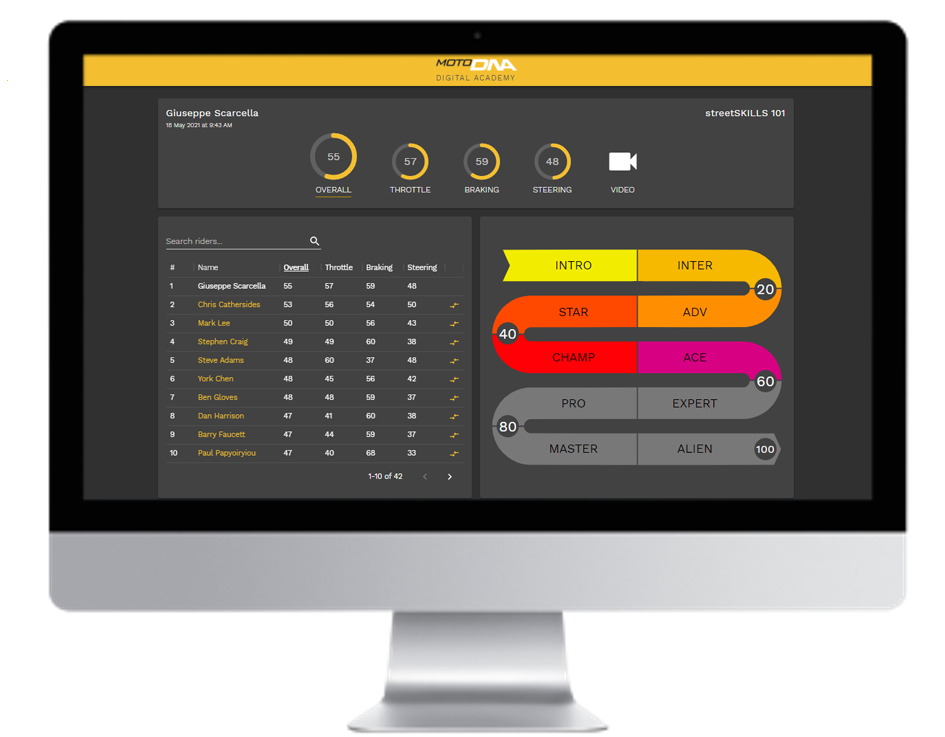How To Accelerate Your Motorcycle Skills …
What’s the difference between the average Joe rider and VR46? We all steer, brake, throttle, lean, look …Everyone has arms, legs, brain …So why are some riders better than others? Apart from fitness, riding motorcycles is all in your head and here’s why.
Does Your Ambition Outweigh Your Talent
The first thing is to be honest with your ability. Here lies a big problem, because humans are programmed with a cognitive bias. Unskilled riders can suffer from illusory superiority, mistakenly assessing their ability much higher than is true.This bias is attributed to a metacognitive inability of the unskilled to recognise their incompetence. In English please … many unskilled riders think their skill level is much higher that reality. Say thanks to Dunning-Kruger for the scientific evidence and be honest with yourself. You may be significantly more unskilled that you perceive.
(Use motoDNA’s streetSKILLS 101 to objectively understand your skill level)
Training
Road riders need good skill to ride safely and proficiently, reducing the chance of a panic reaction on the street and racers need high skills to win! If you are a road rider think about this, nearly half of motorcycle crashes on the road are single vehicle accidents. This means riders are crashing all by themselves.
A small-unexpected trigger such as gravel, an oncoming car across the white line, riding too hot into a corner … often leads to a panic reaction making a minor problem into a big problem which could have been avoided with higher skills.
The rider often lacks adequate understanding of their own limit and the limit of their bike and tyres. Its way too easy, to get a motorcycle license and getting your license is only the beginning of your journey.
Plus, having higher skills would almost certainly help you avoid other typical crashes involving cars.
Training Environment
Practice in a controlled environment where you can make mistakes with low risk. Hint, this is not on public roads. I’ve been through that and trust me it’s a whole world of pain or worse. Now, most controlled environments tend to be race-tracks.
This clearly doesn’t mean that all training at these venues is for racing – duh. I hear a lot of BS about “that’s just for racers” normally from the small minded and training companies that only train on the open road. The importance of practicing in a controlled environment is even recognized by government these days with Queensland’s new pre-learner course now part of the licensing process.
Think for yourself, benefits of training on a track are plenty.
One way, no furniture, no police, heaps of space and no speed limit in a fun and engaging environment with other like-minded folks.
On the track you can run wide, you can run off line and over shoot corners without too much of a problem and you are learning by making small low risk mistakes.
On the road you cannot afford to make any mistakes.
Find A Ride Hacker
A coach’s job is to inspire, guide and nurture you safely through your riding journey.
First thing, what’s your coaches safety record?
I’m amazed at the attitude of some trainers that you need to crash to learn?
This is rubbish.
A good coach can spot a rider trending towards a crash and bring you back on track with the correct attitude and techniques for your ability.
But to get good you need a coach that understands flow.
What is flow?
The Psychologist Csikszentmihalyi describes flow as an exhilarating feeling of transcendence.
You trust your skills and ride intuitively without worry or doubt; resulting in feelings of joy and effortlessness.
Flow is the ultimate performance state where you feel and perform at your best.
To achieve flow a person’s body or mind need to be stretched in a voluntary effort to accomplish something difficult and worthwhile.
Flow appears between boredom and anxiety in what scientists call the flow channel – the spot where the task is hard enough to make us stretch but not too difficult enough to make us snap.
You don’t need to be the best rider in the world to experience flow but you do need to overcome challenges to achieve a sense of mastery in your riding.
The coach’s job is to guide the rider through this flow path, balancing out the challenge to skill ratio.
If the challenge is too low you won’t achieve flow.
You will also not increase your skill and you will stay in your comfort zone.
If the challenge is too high, you will make mistakes, be inconsistent and at a higher risk of crashing.
The trick is to ride slightly outside your comfort zone, increasing your challenge in 5% steps.
Then practice riding at this new level until it becomes intuitive.
This could be increasing your braking performance, leaning the bike over further than you have done before, lifting your eyes to improve vision or increasing your precision and consistency.
Your skill level has now gone up by 5%.
Everyone is different and some riders improve quicker than others, but a good coach can help you find your unique access points into flow which helps play to your strengths also creating more fun with your riding.
So stop spending large on the bling and go faster bits, when the biggest performance gains come from investing in the spacer, you know, the one between the handlebars and seat.
About the Author: Mark McVeigh
Data Driven
Developed from thousands of riders at the motoDNA Motorcycle Training, our algorithms measure, grade and train motorcycle riders.
Objective
No more guessing, data sensor fusion combined with our algorithms deeply understand rider behaviour.
Towards Zero
Our urgent and ambitious aim is to empower the motorcycle community to take back control towards zero.


